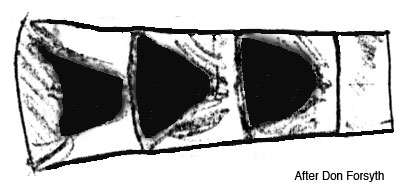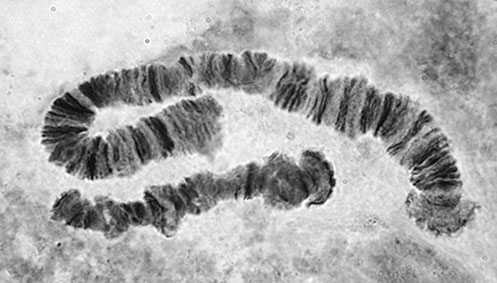6. Chironomus 'castaneum' n. sp. In BOLD Bin: BOLD:AAL7010
Along with C. 'campano' and C. sp. NZ9. (see under C. sp. NZ9 for further detail) This manuscript name was allocated by D.J. Forsyth for specimens from Poutu Canal, Lake Rotoaira, South Auckland. His associated adults were not available for study.
Don described the adult abdomen as having somewhat triangular brown markings on the tergites, that became progressively wider on successive segments. 
Don Forsyth's original drawing of the abdomen of C 'castaneum'.
DNA and cytological data indicated that there was more than one taxon initially included under this name and that North and South Island specimens differ in their mtCOI sequences. North Island form:
Adult:
Abdomen with somewhat triangular brown markings, narrowing towards the posterior margin, on the tergites that become progressively wider on successive segments.Pupa: Spur with 3-5 spines. Fourth instar larva: A salinarius-type larva, length about 16.23 (15.2-16.8) mm (female); 14.1 (12.8-14.8) mm (male). Anal tubules short and normally rounded, usually about the same length although the ventral pair may be longer and narrower; only about 2x as long as wide - occasionally pointed and about the same width as the length.
Frontoclypeus and posterior half to two thirds of gula, dark to very dark, sometimes with some slight darkening at posterior of head capsule. Salivary reservoir relatively deep: 78 µm long and 4.4 times longer than deep.
Mentum (Fig. d) width about 0.68 to 0.77 of VHL; with 4th lateral reduced to about the level of the 5th laterals (type II), c1 tooth broad (broad IIa), 6th laterals turned out.
Ventromentum (Fig. e) about 245 µm wide and 2.95-3.23 wider than deep; separated by about 0.4-0.5 of the mentum width; with about 45.0 (39-55) striaewhich appear to extend almost to anterior margin, particularly at the outer edges; VMR about 0.27.
Premandible Fig. b) of type B2, with outer tooth about 3-5x the width of the outer tooth and coming to a broad point.
Pecten epipharyngis (Fig. a) with about 11.6 (10-14) teeth mostly worn but narrowing towards the edges.
Distance between antennal bases (167.7 (139-245))) less than the distance between the S4 setae (183 (147-263)); S4 setae separated by about 0.94 of the FC width.
Antennae (Fig. c) with basal segment relatively short (0.35-0.43 of VHL) and only about 2.2-3.1 times longer than wide, AR about 2.10-2.14; Ring organ about 0.36 (0.27-0.45) up from base of segment; relative length of segments (µm) 122 : 31 ; 9 : 13 : 7 ; A3 shorter than A4, but longer than A5, but longer than A5.
Mandible (Fig. f) about 249-326 µm long, of type IIB, or occasionally IIC, and with about 18.2 (11-24) furrows on outer surface near base, and 12.5 (10-15) taeniae in Pecten mandibularis; Mdt-Mat about 25, MTR about 0.27. Third instar larva: A single larva was available, about 8.7 mm long; dorsal and ventral anal tubules equal size: 160 µm long and twice as long as wide. Gula slightly darkened over posterior 1/3 to 1/2; Frontoclypes pale.
Mentum width about 0.4 of VHL. Ventromental plates separated by about 0.4 of the mentum width; with 28-30 striae; VMR 0.31-0.38. Premandible with inner tooth about 2.5 times wider than the outer tooth. Pecten epipharyngis with 11 teeth.
Distance between antennal bases about 0.85 of that between the S4 setae. The relationships of A1 to the VHL about the same as in the 4th instar; RO further up from base of segment (0.41-0.53); relative length of segments (µm) 75 : 24 : 8 : 13: 8.
Mandible about 175 µm long, of type IIB; with 22 furrows and 9 taeniae in the Pecten mandibularis. Cytology: 4 polytene chromosomes, with the pseudothummi group arm combination (BF, CD, EA, G).
Distinguished by two nucleoli in chromosome 1 (one proximal in F and one proximal in B). Arm A with a sequence differing from A4 of C. oppositus by a simple inversion which is also found in C. forsythi; arm E commonly differs from E1 of Australian species by a large inversion, although that E1 appears to be present in Poutu Canal population. Arm F1 appears identical to that of C. oppositus F3 and C. australisF1. Arm G often partly unpaired.
Polymorphic in arms A, B, C, D, E and F. casA1: 1a-e, 2e - 3, 1f - 2c, 10 - 11, 2d, 8 - 9, 3f-i, 12c-a, 4 - 7, 13 - 19 as zeaA1 & forA2
casA3: 1a-e, 12a-c, 3i-f, 9 - 8, 2d, 11 - 10, 2c - 1f, 3 - 2e, 4 - 7, 13 - 19 from casA1 (Poutu & Winton)
casB1: Nucleolus just distal to 4 characteristic bands (groups 24 - 26), and puff with proximal dark bands (groups 8-7) near distal end,
i.e. by small inv. from forB2
casB2: Inversion of distal third of arm, as nzlB3, bringing puff and proximal dark bands (groups 7-8) close to the telomere.
casC1: Characteristic band groups 4-3 about 1/3 from distal end, with 6-5 distal to them. as as nzlC1, tepC1.
casD1: as forD1
casD2: as forD2
casD3: small proximal inversion from casD1, just proximal to breakpoint of D2.
casE1: 1 - 3e, 10b - 3f, 10c - 13 i.e. as oppE1, anlE1, forE1, nzlE1
casE2: 1a-e, 3f - 10b, 3e - 2a, 10c - 13 i.e. as forE2
casF1: 1 - 2a, 10 - 2c, 15c - 11a, 2b, 15d - 23 i.e. as oppF3, anlF1, forF1, nzlF1
casG1: with subterminal nucleolus. Differs from forG1 by an inversion around the median BR.
Arms A1E1 and G1 of C. sp. 'castaneum'.
Known Localities
North Island:
Lake Karapiro, South Auckland (NZ.77.1) (Sofia Ibarrarán) 27-viii-2007
Lake Okaro, nr. Rotorua, South Auckland (NZ.10.9) (Sofia Ibarrarán) 14-ix-2008
Lake Okareka, Wellington District (NZ.82.1) (Sofia Ibarrarán) 28-viii-2007
Poutu Canal (39.07°S, 175.75°E), Lake Rotoaira (NZ.70.1) (D.J.Forsyth) 8-x-1990 (Forsyth's type locality)
Lake Rotoaira (39.056°S, 175.705°E), South Auckland (NZ.70.2) (Sofia Ibarrarán) 14-ii-2007 and (NZ.70.3) 27-viii-2007 South Island:
Haast junction, 3 km w Haast (43.88°S, 169.05°E), Westland (NZ.67.1) (Jon Martin) 25-i-1978
Winton (46.10°S, 168.20°E), Southland (NZ.43.1) (Jon Martin) 5-i-1974 The evidence for the presence of more than one species comes from both the cytology and the mtCOI sequence.
At the type locality there is A1 and A2; B1 and B2; C1; mainly D2 with D1 and D3; E1 and E2; F1; and G1.
At Haast there is A2; B1 and B3; C2; D1; E1; F1; and G2.
MtCOI:
Some sequence is in the BOLD database. [ Return to Key| Go to References | Go to C. 'campano' | C. sp. NZ9; | C. sp. NZ10; ] |

